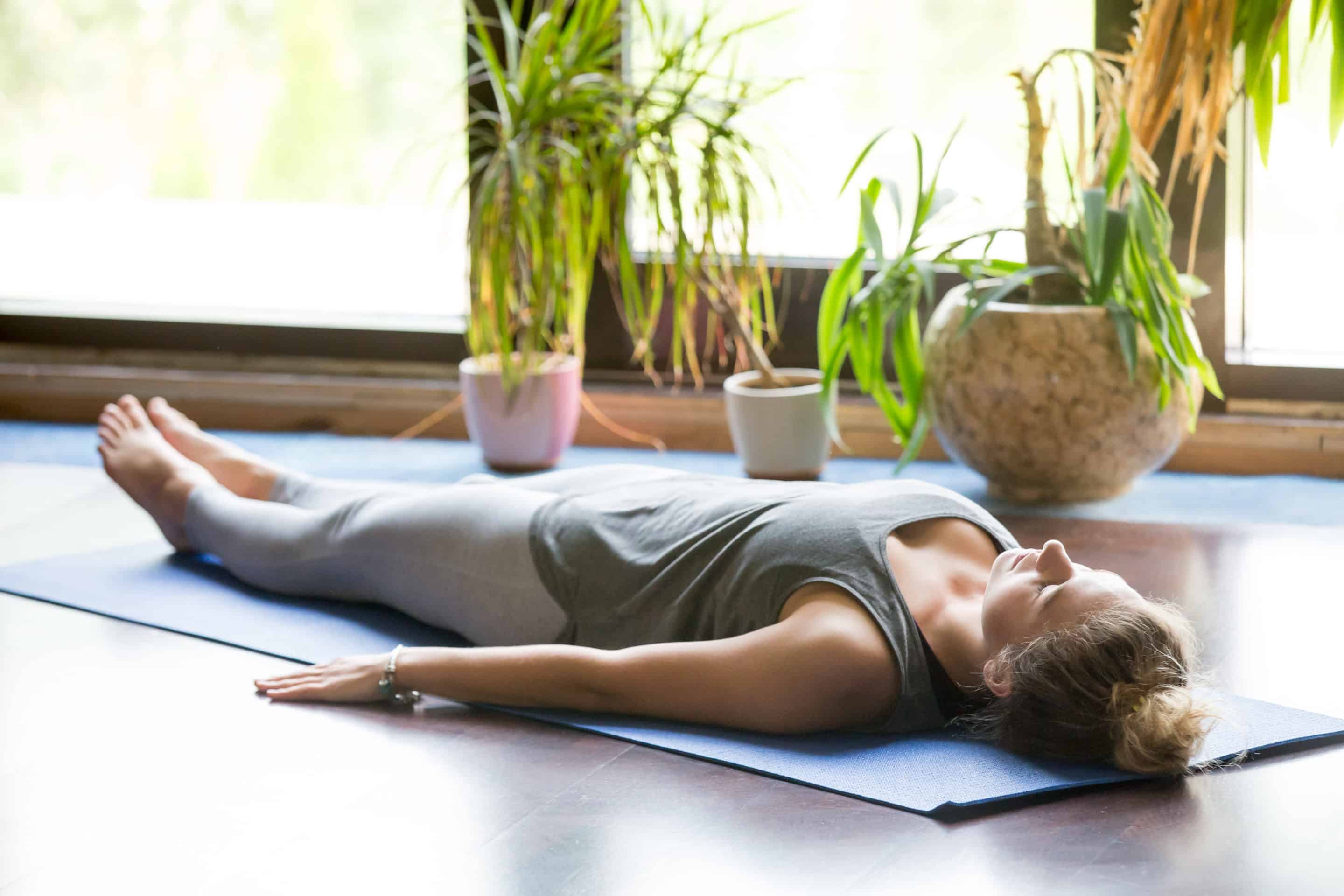While the origins of yoga date back over 5,000 years, the meditative practice has never been more popular than it is today, and its methods and uses have flourished over the millennia. Today over 36 million people throughout the United States regularly practice yoga as the techniques have continued to grow and develop.
Modern forms of yoga vary greatly and are each used for different reasons. These forms of yoga range from bikram yoga, vinyasa yoga, and prenatal yoga to our focus in today’s article, yoga nidra.
Yoga nidra can be especially effective when it comes to calming your nervous system and promoting better sleep— especially if you’re having a hard time getting restful sleep. Although further research is required, studies have shown yoga to also be a constructive addition to the treatment of your sleep apnea symptoms.
So, what is yoga nidra, and how can it help the restless soul?
What is Yoga Nidra?
Yoga nidra, also known as yogic sleep, is an ancient practice intended to help your body relax while your mind is alert.
The goal is to achieve a state of consciousness between being awake and being asleep while guiding yourself through the four stages of brain wave activity. These stages are known as beta, alpha, theta, and delta.
- Beta: Beta waves are produced when your brain is actively engaged in mental activity, such as an active and engrossing conversation.
- Alpha: Alpha waves are slower, and indicate less arousal in the brain. These occur when your brain is resting after being in an aroused state, such as when you take a break after a long focus session.
- Theta: Theta waves also indicate less arousal in the brain, such as when you’re zoning out or daydreaming.
- Delta: Delta waves have the slowest frequency, and occur while you are sleeping.
Benefits of Yoga Nidra
Proper use of yoga nidra can help with your sleep onset, ensuring you fall asleep quickly and are able to stay asleep throughout the night. Other benefits of yoga nidra include:
- Helping calm your sympathetic nervous system, otherwise known as the “fight or flight” response, and fosters a feeling of soothing relaxation
- Helping your body naturally release the sleep hormone melatonin and prepare your body to rest
- Reducing anxiety and promoting serenity
Yoga nidra has a long history of use supporting patients experiencing mental and physical conditions. It’s been used to help patients with post-traumatic stress disorder (PTSD), anxiety, depression, and even diabetes and menstrual disorders.
One study found that both meditation and yoga nidra was helpful in reducing anxiety, with yoga nidra proving to have a more calming effect. [1]
Yoga nidra is typically done via guided meditation with a yoga instructor, but you can also guide yourself through it. We’ll talk more about this later.
What’s the Difference Between Yoga Nidra and Other Yoga Practices?
Hatha Yoga is an umbrella term that includes many of the traditional forms of yoga practices in the United States. It’s based on techniques that are meant to balance physical and mental health. This old system includes the use of breathing exercises and yoga postures known as asanas.
Not all yoga includes movement or holding poses, in fact, Yoga nidra literally means yogic sleep and doesn’t include any movement at all.
While traditional yoga and yoga nidra both center around the relation of mind to body, yoga nidra dives further into the meditative aspect of the practice. Most forms of yoga put an emphasis on the asanas, otherwise known as yoga poses.
Yoga nidra however, is practiced solely from a position of total relaxation, known as the Corpse Pose. The Corpse Pose is simply laying flat on your back. This position can be practiced on the floor, in the comfort of your bed, or anywhere that allows you to completely relax your body.
Rather than using your body, yoga nidra’s purpose is based on mental exercise. The focus isn’t on the physical poses, but on achieving a certain state of mind.
Can Yoga Nidra Help with Sleep Disorders?
It can! In fact, yoga nidra could be an effective treatment option if you’ve been struggling with insomnia. While it can’t resolve the issue, especially if you have chronic insomnia, it can be a very healthy and beneficial habit to get into to help yourself sleep.
Yoga Nidra For Insomnia
A study published by Sleep Science and Practice observed the effects that yoga nidra had on two insomnia patients— both older men with sleep problems. After their initial assessment, they were provided with five supervised yoga nidra sessions before practicing daily on their own for four weeks.
The researchers found that yoga nidra can help treat chronic insomnia— especially when used to complement additional treatment options. [2]
Additionally, the participants experienced improved sleep quality after practicing yoga nidra. They also saw improvements in depression and anxiety symptoms, as well as reduced stress levels.
Combining Traditional Yoga Poses with Yoga Nidra For Sleep Apnea
Yoga nidra can help you relax before bed, supporting deeper and more restorative sleep. Combining it with more traditional yoga asanas and movement can help you sleep better in some unexpected ways.
According to numerous studies, yoga poses and movement can be especially helpful for obstructive sleep apnea because of how it compliments CPAP therapy.
CPAP, or continuous positive airway pressure, uses a gentle, constant stream of pressurized air to open your airways and help you breathe normally as you sleep. It’s the most effective and popular treatment for sleep apnea.
One study published by the Indian Journal of Otolaryngology and Head & Neck Surgery found that practicing yoga can be an effective complement to sleep apnea therapies like CPAP.
The study observed 37 patients with mild to severe OSA, or who complained of snoring. Each patient was assigned a series of yoga poses to practice over three months to help them with their nasal breathing, as well as to exercise the muscles in their faces and throats. [3]
Participants that adhered to their yoga practice saw a reduction in the severity of their OSA symptoms, as well as improvements in sleep quality, snoring frequency, and severity.
It’s also worth noting that in this study, many of the participants were male, middle age, and overweight or obese.
Researchers also reported that most of the participants also saw a drop in their baseline body mass index (BMI) and neck circumference after 3 months. This is significant because excess body weight and neck circumference can obstruct your upper airway and contribute to your sleep apnea symptoms.
In short, the researchers found that a consistent yoga practice can help sleep apnea patients breathe and sleep better, especially when they followed their CPAP treatment.
So with all this in mind, you’re probably wondering now: “How do you practice yoga nidra?” It’s a simple practice you can do from the comfort of your bedroom. Let’s explore the practice so you can add it to your night routine to help improve your sleep.
How Do You Practice Yoga Nidra?
There are many yoga classes that offer yoga nidra lessons, but you don’t need an instructor. It’s also an easy practice to do on your own once you know the process.
If you have a smartphone there are many apps, such as Yoga Nidra on the App Store or Google Play, as well as videos available online that can guide you through your yoga nidra sleep meditation sessions. Here are a few things to do before you get started.
First, lie flat on your back in the Corpse Pose— you can do this in bed, on a yoga mat, or on the Higher Dose PEMF mat. Make sure your head, spine, and lower back are relaxed and properly supported. You can use pillows or a yoga bolster to add more support if needed. Once comfortable, you can begin the mental process:
- First, visualize a lifelong goal or something related to your health— like better sleep or deep relaxation.
- Set an intention for why you’re practicing, and keep it in mind throughout the session.
- Find a safe place in your mind. This helps you feel more at ease while you practice.
- Be aware of your body. Focus on any sensations you feel— this will help you reduce the tension there so you can relax.
- Be aware of your breath. Notice how it enters and leaves your body, as well as how your abdomen rises and falls as you breathe. This helps you slow down and breathe more deeply and evenly.
- Acknowledge your feelings— good or bad. When you process your feelings, you can help yourself work through them and feel more balanced.
- Observe your thoughts as they happen. If any negative thoughts arise, think about more positive aspects of those thoughts. This helps prevent stress and tension while you’re trying to enter that deep relaxation.
- If you feel happy or joyful, embrace it!
- Be aware of how you’re feeling, and try observing those feelings outside of yourself. This can help you become more in tune with your feelings.
- When you finish, spend a few minutes reflecting on your practice. How do you feel? How can you bring the joy you felt into your daily life?
More Tips for Practicing Yoga Nidra
Just like with anything else, mastering yoga nidra takes practice and dedication. Here are a few tips to help you master yoga nidra and fully reap its restorative benefits:
- Use a sleep mask to block out any light or distractions that can take away from your practice.
- Always practice somewhere quiet, and with minimal distractions.
- Start with shorter sessions— around 15 to 20 minutes. You can always move to longer sessions once you have more experience.
- Your body cools down while you’re at rest. Before you start, cover up with a blanket. This is especially important if you get cold easily.
Can’t Sleep? Give Yoga Nidra a Try
Yoga is great for getting a good night’s sleep thanks to its physical and emotional benefits. Yoga nidra is an especially great way to help yourself get restful deep sleep. It can also reduce anxiety, and help you become more in touch with your emotions.
Yoga nidra can also be helpful if you’re suffering from occasional insomnia by reducing anxiety (often the cause of delayed sleep onset) and helping to provide calm and prepare your brain for sleep. As a whole, yoga can also complement CPAP therapy for sleep apnea by helping improve your breathing patterns and the muscle tone in your throat.
Still, struggling to fall asleep and get the restful sleep you need? We have many great resources available on our website including how to create a sleep environment to help you fall asleep more easily.
For more serious chronic insomnia conditions, our team of Advanced Practice Providers (APP) Sleep Specialists can diagnose and provide ongoing care for insomnia. They’re trained in the most effective forms of treatment, including the first line of recommended treatment for insomnia. Contact us today for an evaluation. Our offices are located in Clarksville, Franklin, and Murfreesboro. We can help you get the attention you need to get a good night’s sleep again.
References
1. Ferreira-Vorkapic, Camila, et al. “The Impact of Yoga Nidra and Seated Meditation on the Mental Health of College Professors.” International Journal of Yoga, Medknow Publications & Media Pvt Ltd, 2018, www.ncbi.nlm.nih.gov/pmc/articles/pmc6134749/.
2. Datta, Karuna, et al. “Yoga Nidra: An Innovative Approach for Management of Chronic Insomnia— A Case Report — Sleep Science and Practice.” BioMed Central, BioMed Central, 12 Apr. 2017, sleep.biomedcentral.com/articles/10.1186/s41606-017-0009-4. 3. Kumar, Vivek, et al. “Application of Standardised Yoga Protocols as the Basis of Physiotherapy Recommendation in Treatment of Sleep Apneas: Moving beyond Pranayamas.” Indian Journal of Otolaryngology and Head and Neck Surgery : Official Publication of the Association of Otolaryngologists of India, Springer India, Oct. 2019, www.ncbi.nlm.nih.gov/pmc/articles/PMC6848556/.

